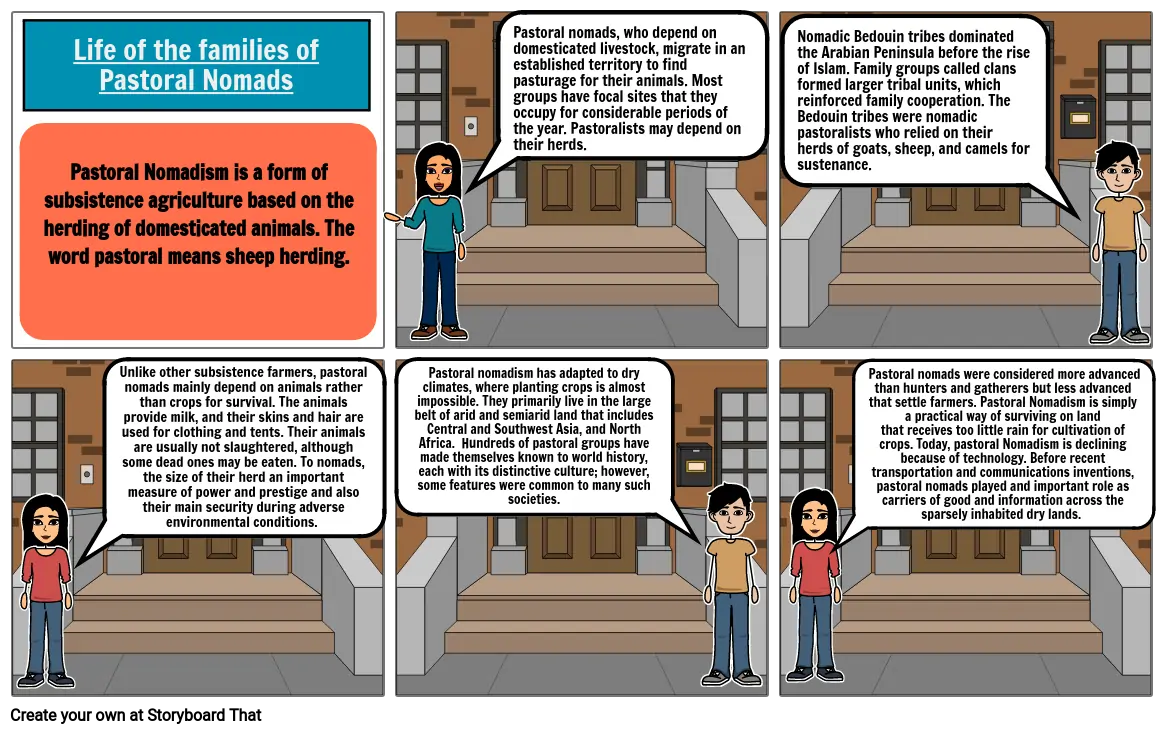Life of Nomadic Pastorals

Storyboard Text
- Pastoral Nomadism is a form of subsistence agriculture based on the herding of domesticated animals. The word pastoral means sheep herding.
- Life of the families of Pastoral Nomads
- Pastoral nomads, who depend on domesticated livestock, migrate in an established territory to find pasturage for their animals. Most groups have focal sites that they occupy for considerable periods of the year. Pastoralists may depend on their herds.
- Nomadic Bedouin tribes dominated the Arabian Peninsula before the rise of Islam. Family groups called clans formed larger tribal units, which reinforced family cooperation. The Bedouin tribes were nomadic pastoralists who relied on their herds of goats, sheep, and camels for sustenance. Click To EditNomadic Bedouin tribes dominated the Arabian Peninsula before the rise of Islam. Family groups called clans formed larger tribal units, which reinforced family cooperation. The Bedouin tribes were nomadic pastoralists who relied on their herds of goats, sheep, and camels for meat, milk, cheese, blood sustenance. Help Insert ParagraphUndoes the last commandRedoes the last commandTabUntabSet a bold styleSet a italic styleSet a underline styleSet a strikethrough styleClean a styleSet left alignSet center alignSet right alignSet full alignToggle unordered listToggle ordered listOutdent on current paragraphIndent on current paragraphChange current block's format as a paragraph(P tag)Change current block's format as H1Change current block's format as H2Change current block's format as H3Change current block's format as H4Change current block's format as H5Change current block's format as H6Insert horizontal rulelinkDialog.show Summernote 0.8.11 · Project · Issues
- Unlike other subsistence farmers, pastoral nomads mainly depend on animals rather than crops for survival. The animals provide milk, and their skins and hair are used for clothing and tents. Their animals are usually not slaughtered, although some dead ones may be eaten. To nomads, the size of their herd an important measure of power and prestige and also their main security during adverse environmental conditions.
- Pastoral nomadism has adapted to dry climates, where planting crops is almost impossible. They primarily live in the large belt of arid and semiarid land that includes Central and Southwest Asia, and North Africa. Hundreds of pastoral groups have made themselves known to world history, each with its distinctive culture; however, some features were common to many such societies.
- Pastoral nomads were considered more advanced than hunters and gatherers but less advanced that settle farmers. Pastoral Nomadism is simply a practical way of surviving on land that receives too little rain for cultivation of crops. Today, pastoral Nomadism is declining because of technology. Before recent transportation and communications inventions, pastoral nomads played and important role as carriers of good and information across the sparsely inhabited dry lands.
Over 30 Million Storyboards Created

